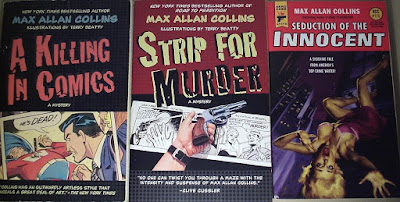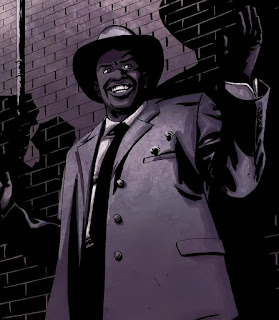Aquaman has long been the Rodney Dangerfield of the DC universe. He gets no respect. Born to the Queen of Atlantis, saddled with the very un-superhero-like name of “Arthur,” and raised by his human lighthouse keeper father, the goofy-looking Marine Marvel is the butt of numerous “You’re more useless than Aquaman” jokes on Family Guy, the gist of which is that the power to get fish to do stuff has little practical value.
Then in 2016, in the otherwise disastrous Batman v. Superman, we got a brief glimpse of a different Aquaman. Played by Jason Momoa (known to Game of Throne fans for his role as Khal Drogo), this buff, bearded version of the Dweller-in-the-Depths looked kind of rad.
We saw more of him last year in Justice League and discovered he’s hard-drinking and has a sense of humor. “Dress like a bat. You’re out of your mind, Bruce Wayne.” Kind of an aquatic Wolverine.
But it wasn’t until a scene early in the new Aquaman movie, which opens today across the nation, that I was truly convinced: this is not your father’s Aquaman.
It’s a fight scene, Aquaman against the father-and-son pirate team of Jesse and David Kane, aka Manta. The Kanes are attempting to steal a Russian submarine. They’ve killed the captain and many of the crew; the survivors are holed up in the torpedo room, neutralized. Aquaman bursts through a hatch, and after a quip (“Permission to come aboard”) proceeds to take the Kanes and their henchmen apart. The action ends with the crew safely evacuated and Daddy Kane trapped under a missile as water floods the compartment. “Wait!” Manta yells to Aquaman. “You can’t leave him here. Help me! Please!”
We’ve seen the scenario a million times, and the hero always rescues the trapped villain, who really doesn’t deserve it. But not this time. “Ask the sea for mercy,” Aquaman tells him. And then he leaves.
Totally. Bad. Ass.
The theft of the submarine is just the first step in a scheme by Aquaman’s half-brother, Orm, monarch of one of the seven Atlantean kingdoms. I wasn’t really sure which one; the politics of Atlantis are intricate and confusing. A clunky exposition scene tries to explain it all, but it doesn’t help much. I was reminded of the Star Wars prequels’ debates over the taxation of trade routes to outlying star systems. I’m not even sure if there really are seven kingdoms. I think some are extinct. Anyway, Orm plans to use the submarine in a false flag attack to unite however many kingdoms there are for a war against the surface dwellers. Because pollution of the oceans or something. Fortunately for him, Aquaman just abandons the still-functioning submarine after he defeats the pirates. The Russian Navy, inexplicably, makes no attempt to salvage it, thereby allowing Orm to just take it and make the movie happen.
In any case, not all Atlanteans are arming for war. The beautiful redhead Mera, daughter of the King of…one of the kingdoms, seeks out Aquaman and accosts him with a Call to Adventure: she begs him to come to Atlantis, challenge his brother for the throne, and thereby stop the war. True to the Hero’s Journey, Aquaman initially refuses. Not my circus, not my monkeys. But events conspire against him and before long he is under the sea, threatening Orm with an “ass-whooping.”
DC movies since 2005’s Batman Begins have a reputation for being grim. It even inspired a joke in rival Marvel’s Deadpool 2, in which Deadpool says to the straitlaced Cable, “You're so dark. Are you sure you're not from the DC universe?” But Aquaman has a different feel to it. Part of it is that, starting with last year’s Wonder Woman, DC is finally putting humor into its movies. For example, in one scene, Mera impulsively jumps out of an airplane—without a parachute. Seeing the shocked look of the pilot, Aquaman says, “Redheads, you gotta love them.”
But it’s not just the one-liners. Aquaman has a very different visual feel from previous entries in the DC Extended Universe. Instead of the grimy, hyper-realistic, claustrophobic urban setting of Gotham, we’re out in the open, in the vast spaces on the ocean surface—and beneath. The colors are bright. We even spend some time in a cheerful Mediterranean seaside village. The underwater CGI seascapes really dazzle.
But sadly, despite a very likable and kick-ass Aquaman, some funny one-liners, and stunning visuals, this movie isn’t that great. It's not terrible, there's no "Martha" moment. Just not great. The problem is the script. It just fails to sparkle in so many ways. I already mentioned the ponderous exposition and the plot hole concerning the submarine. The dialog is not up to par. What’s supposed to pass as witty, romantically-charged banter between Aquaman and Mera frequently falls flat. And once it is set into motion, the plot is entirely predictable. There is only one twist to speak of, and I saw it coming a mile away. I even knew exactly what the last scene was going to be long before the end.
Still, I hope Aquaman does well at the box office. Now that Jason Momoa has given the character a much-needed makeover, I’m eager to see him back in a better movie.
| Michael Isenberg drinks bourbon and writes novels. His latest book, The Thread of Reason, is a murder mystery that takes place in Baghdad in the year 1092, and tells the story of the conflict between science and shari’ah in medieval Islam. It is available on Amazon.com |






















